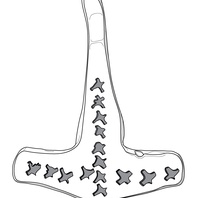
Viking Designs
Drawing of a Hammer-Shaped Pendant
A drawing of a gold hammer-shaped pendant, popularly called a Thor’s hammer pendant, from Spilsby, Lincolnshire. These may have been worn to show devotion to the god Thor, or to secure the god’s protection, although there is little evidence to support this interpretation. Pendants like this have been found made of lead, copper alloy, silver and gold, showing that many different strata of society could have worn them.
Read More
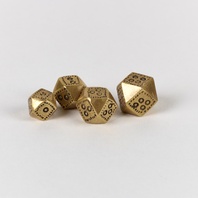
Viking Objects
Reproduction Polyhedral Weights
A group of four polyhedral weights of a type that is common throughout the Viking diaspora. This example has fourteen sides and four dots on each of the rectangular sides. These weights were adopted by the Vikings from Middle Eastern examples and appear to have become a de facto weight standard for traders.
Read More
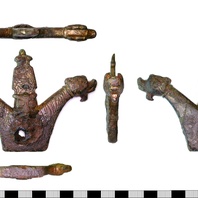
Viking Objects
Mystery Item
A gilded, copper alloy object that was clearly affixed to something else. The gilding shows that it was high status but its function remains a mystery.
Read More
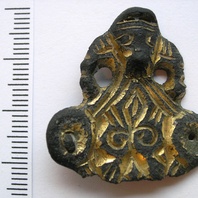
Viking Objects
Equal-Armed Brooch (SWYOR-50BAF5)
A fragment of a Viking Age equal-armed brooch found at Harworth Bircotes, Nottinghamshire. This fragment is the terminal of the brooch and resembles brooches found at Birka, Sweden. Its decoration consists of a Borre style animal with gripping arms or legs. This is one of only six Scandinavian, Viking period equal-armed brooches recorded in England. For more information on Scandinavian jewellery in England check out our blog: Brooches, Pendants and Pins: Scandinavian Dress Accessories in England.
Read More
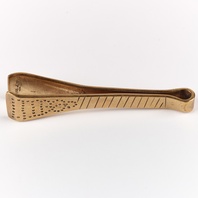
Viking Objects
Reproduction Tweezers
Tweezers were an essential toilet item for the Vikings and most people would have had their own. They could be highly decorated as were many personal possessions. They would have been carried suspended from a brooch or belt.
Read More
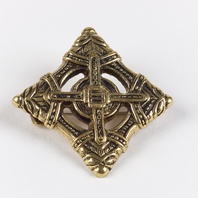
Viking Objects
Reproduction Lozenge Brooch
A copper alloy lozenge brooch in the Borre style based off a find in Lincolnshire. This type of brooch was common throughout the Danelaw in the Viking Age and was used as an accessory by women who wore Scandinavian dress. Scandinavian brooches came in a variety of sizes and shapes which included disc, trefoil, lozenge, equal-armed, and oval shapes. The different brooch types served a variety of functions in Scandinavian female dress with oval brooches typically being used as shoulder clasps for apron-type dresses and the rest being used to secure an outer garment to an inner shift. Anglo-Saxon brooches do not match this diversity of form with large disc brooches being typical of ninth century dress styles with smaller ones becoming more popular in the later ninth and tenth centuries. However, since disc brooches were used by both Anglo-Saxon and Scandinavian women they are distinguished by their morphology. Scandinavian brooches were typically domed with a hollow back while Anglo-Saxon brooches were usually flat. Moreover, Anglo-Saxon brooches were worn singly without accompanying accessories.
Read More
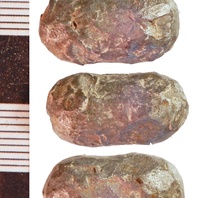
Viking Objects
Silver Ingot (NLM-ABB952)
This silver ingot was made by melting down worked silver and casting it in a mould. The Vikings arriving in England had a bullion economy in which they paid for goods with silver that was weighed to an amount agreed between the buyer and the seller. Hacksilver and silver ingots are the most common evidence for their bullion economy. It took some time for the Scandinavian settlers to adopt a monetary economy like that of the Anglo-Saxons, and both systems were used simultaneously for a while before they fully adopted the new system. The Vikings were familiar with monetary economies but they treated coins as just another form of silver before adoption of a monetary economy.
Read More
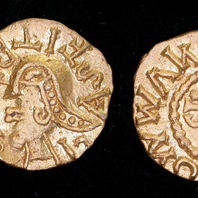
Viking Objects
Merovingian Tremissis (LEIC-6BAA60)
This Merovingian gold tremissis was minted in Bourges in the late 6th or 7th century. It is possible that it made its way to England prior to Viking incursions but it is equally likely that the Vikings brought this coin with them as plunder after raiding in Frankia.
Read More
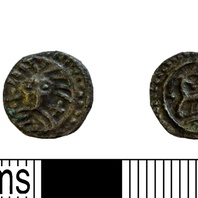
Viking Objects
Danish Silver Sceat (NARC-70AFF4)
This silver sceat is classified as part of the Danish Series X Type 31. The obverse depicts the head of Woden with crosses to either side of a rounded beard and pellet above. The reverse depicts a monster facing left. These coins are considered to be associated with the early trading center at Ribe. It is very likely that they made their way to England by means of Vikings.
Read More
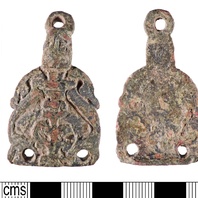
Viking Objects
Stirrup-Strap Mount (LIN-D274D5)
This Anglo-Scandinavian cast copper-alloy stirrup-strap mount is decorated with zoomorphic ornamentation. It has been classified as a William Class A Type 6 mount.
Read More
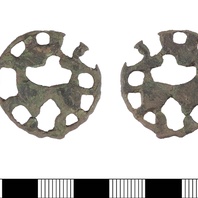
Viking Objects
Urnes-Style Mount (LIN-FA6943)
This copper-alloy mount features Urnes-style openwork decoration.
